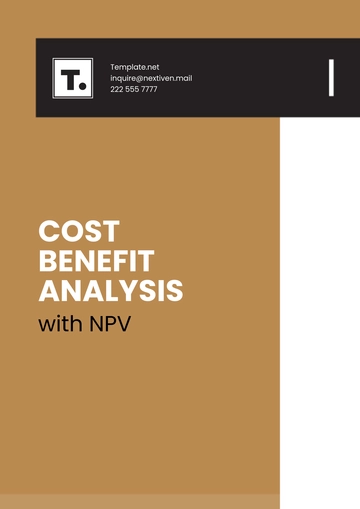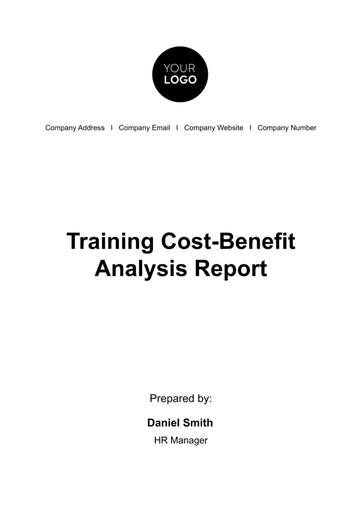Free Influencer Marketing ROI Advertising Analysis

1. Executive Summary
This report provides an in-depth analysis of the Return on Investment (ROI) from influencer marketing initiatives undertaken by [Your Company Name]. These campaigns, pivotal in our strategic marketing efforts, have been tailored to bolster our brand's visibility, foster robust audience engagement, and drive significant sales conversions.
Our focus has been on leveraging influential personalities across various social media platforms to amplify our brand's message. By doing so, we aim to tap into the substantial follower bases of these influencers, thereby gaining access to a more engaged and receptive audience. The rationale behind this approach is to not only increase brand awareness but also to build a sense of trust and authenticity around our products and services.
This analysis meticulously quantifies the impact of these influencer partnerships on our overall marketing performance. Key performance indicators (KPIs) such as website traffic, social media engagement metrics, conversion rates, and sales volumes have been scrutinized to offer a clear picture of the effectiveness of these campaigns.
Moreover, this report delves into the budget allocation and expenditure for each campaign, providing a transparent view of the financial investment versus the returns garnered. By comparing the pre and post-campaign metrics, we aim to illustrate the tangible value added by influencer marketing to our business.
The ultimate goal of this analysis is to provide actionable insights and strategic recommendations for [Your Company Name] to optimize future influencer marketing endeavors. By understanding the successes and learning from the challenges faced in these campaigns, we aim to refine our marketing strategies, ensuring a consistently high ROI and strengthening our position in the competitive market.
This executive summary encapsulates the strategic importance of influencer marketing in our advertising efforts, highlighting its role in enhancing brand perception, engaging potential customers, and ultimately driving sales growth.
2. Campaign Overview
The following section provides a comprehensive overview of the influencer marketing campaigns conducted by [Your Company Name]. This summary is integral in assessing the scope, budget allocation, and strategic platform choice for each campaign. The table below outlines key details including the campaign name, duration, budget, and the primary social media platform utilized.
Campaign Information:
Campaign Name | Start Date | End Date | Total Budget | Main Platform |
[Campaign 1] | [Date] | [Date] | $[000.00] | |
[Campaign 2] | [Date] | [Date] | $[000.00] | YouTube |
Through detailed analysis of these elements, [Your Company Name] seeks to optimize its influencer marketing strategies, ensuring better engagement, reach, and return on investment in future campaigns.
3. Influencer Profiles
Understanding the profile of each influencer is crucial for assessing their potential impact on our campaigns. The table below lists each influencer, along with their follower count, engagement rate, and niche. This information provides valuable insights into the influencer's reach, audience interaction, and area of expertise.
Influencer Details:
Influencer | Followers | Engagement Rate | Niche |
[Influencer 1] | 500,000 | 3.5% | Lifestyle |
[Influencer 2] | 1,200,000 | 4.2% | Fitness |
Influencer: This column names the influencer involved in the campaign. Influencers are chosen based on their relevance to the campaign theme and their alignment with the brand's values.
Followers: The number of followers indicates the influencer's reach. For instance, [Influencer 1] with 500,000 followers suggests a substantial audience, while [Influencer 2] with 1,200,000 followers indicates an even broader reach. This metric is essential in understanding the potential exposure the campaign can achieve.
Engagement Rate: Engagement rate, shown here as a percentage, is a critical metric in influencer marketing. It measures the level of interaction (likes, comments, shares) that the influencer's content receives relative to their follower count. [Influencer 1] with a 3.5% engagement rate and [Influencer 2] with a 4.2% rate indicate high levels of audience interaction, crucial for campaign effectiveness.
Niche: This describes the primary area of focus or expertise of the influencer. For example, [Influencer 1] specializes in 'Lifestyle' content, which may include fashion, travel, or daily activities, whereas [Influencer 2] is focused on 'Fitness', offering content related to health, exercise, and wellness. Selecting influencers whose niche aligns with the campaign's objectives is vital for ensuring message resonance and audience relevance.
By aligning the campaign with the right influencers, [Your Company Name] can effectively tap into targeted audience segments, enhancing the campaign's reach and impact. Understanding each influencer's profile allows for a strategic and tailored approach to influencer marketing.
4. Budget Allocation
Accurate budgeting and financial tracking are pivotal in assessing the efficacy and efficiency of our marketing efforts. The table below compares the budgeted amounts against the actual expenses incurred, revealing insights into our financial management and identifying areas for improvement.
Financial Overview:
Item | Budgeted Amount | Actual Amount | Difference |
Influencer Fees | $[000.00] | $[000.00] | $[000.00] |
Content Production | $[000.00] | $[000.00] | $[000.00] |
Platform Fees | $[000.00] | $[000.00] | $[000.00] |
Miscellaneous Expenses | $[000.00] | $[000.00] | $[000.00] |
Total | $[000.00] | $[000.00] | $[000.00] |
Influencer Fees: This line item covers the compensation paid to influencers. It's a critical investment as influencers are the driving force of our campaigns. The difference between the budgeted and actual amounts can indicate negotiation outcomes or changes in campaign strategy.
Content Production: This includes costs associated with creating campaign content, such as videos, graphics, and written materials. Deviations in this area often reflect adjustments in creative direction or quality requirements.
Platform Fees: These expenses are related to the use of various platforms (like Instagram, YouTube, etc.) for hosting and promoting content. This can include advertising fees and promotional costs essential for maximizing campaign reach.
Miscellaneous Expenses: This category captures unforeseen or indirect costs that arise during the campaign, such as travel, additional software tools, or emergency expenses.
Total: This represents the overall financial commitment of [Your Company Name] towards the influencer marketing campaigns. The variance between the budgeted and actual totals is a key indicator of financial management effectiveness.
By closely monitoring these expenses, [Your Company Name] ensures that each campaign is not only creatively successful but also financially sound. This thorough financial scrutiny allows for more strategic budget allocation in future campaigns, optimizing both cost and impact.
5. Performance Metrics
The following section provides a comprehensive analysis of the key performance metrics associated with the influencer marketing campaigns executed by [Your Company Name]. Measuring these metrics pre- and post-campaign offers valuable insights into the effectiveness of our strategies and their impact on our overall marketing objectives. The table below outlines crucial data points, including website traffic, social media engagement, conversion rates, sales volume, and cost per acquisition (CPA).
Performance Analysis:
Metric | Pre-Campaign | Post-Campaign | Variance |
Website Traffic | [Number] | [Number] | [Number] |
Social Media Engagement | [Percentage]% | [Percentage]% | [Number] |
Conversion Rate | [Percentage]% | [Percentage]% | [Number] |
Sales Volume | $[000.00] | $[000.00] | $[000.00] |
Cost per Acquisition (CPA) | $[000.00] | $[000.00] | $[000.00] |
Website Traffic: This metric tracks the number of visitors to the company's website. An increased post-campaign indicates successful traffic redirection from influencer platforms.
Social Media Engagement: Measured in percentage, this reflects the level of interaction (likes, comments, shares) on social media platforms. A higher post-campaign percentage suggests enhanced audience engagement due to influencer influence.
Conversion Rate: This percentage indicates the proportion of visitors who took a desired action (like making a purchase). Improvement post-campaign signifies a more effective call-to-action and influencer alignment with audience interests.
Sales Volume: Represented in dollars, this metric measures the total sales generated. A positive variance indicates a successful campaign in driving sales.
Cost per Acquisition (CPA): This is the cost of acquiring each customer, calculated by dividing the total campaign cost by the number of conversions. A lower post-campaign CPA is indicative of a more cost-effective campaign.
By examining these metrics, [Your Company Name] can gauge the direct impact of influencer marketing campaigns on business performance. This data not only validates the effectiveness of current strategies but also guides future marketing decisions, ensuring a continuous cycle of improvement and growth.
6. ROI Calculation
One of the most critical aspects of any marketing campaign is understanding its Return on Investment (ROI). This section is dedicated to calculating and analyzing the ROI for the influencer marketing campaigns conducted by [Your Company Name]. This calculation helps in determining the financial effectiveness of our marketing strategies and in making informed decisions for future campaigns.
ROI Formula and Calculation
In order to provide a clear and structured view of the ROI calculation for the influencer marketing campaigns of [Your Company Name], the following table is designed to outline the formula and its application using the specific financial figures of the campaign.
ROI Table:
Item | Description | Formula/Amount |
Formula for ROI Calculation | ROI = (Total Revenue - Total Investment) / Total Investment × 100% | |
Total Revenue | The total income generated from the campaigns | $[000.00] |
Total Investment | The total amount spent on the campaigns | $[000.00] |
ROI Calculation | Application of the ROI formula with campaign figures | |
This table provides a systematic approach to understanding the Return on Investment calculation. By inserting the specific values for total revenue and total investment into the formula, [Your Company Name] can easily compute the ROI percentage, which is an essential metric for evaluating the financial effectiveness of its marketing strategies. A clear comprehension of this calculation aids in making informed decisions for future marketing activities and budget allocations.
Detailed Financial Breakdown:
Description | Amount |
Total Revenue | $[000.00] |
Total Investment | $[000.00] |
ROI | [Percentage]% |
Total Revenue: This represents the total income generated from the influencer marketing campaigns. It includes all sales revenues directly attributable to the campaigns.
Total Investment: This is the total amount spent on the influencer marketing campaigns. It encompasses all expenses, including influencer fees, content production costs, platform fees, and any other associated expenditures.
ROI: The ROI percentage reflects the efficiency of the investment in terms of the revenue it generates. A positive ROI indicates that the revenue outweighs the investment, signifying a successful campaign. Conversely, a negative ROI would suggest a need for strategy reassessment.
This ROI calculation is a fundamental tool for [Your Company Name] in evaluating the financial success of its marketing endeavors. By meticulously analyzing this metric, the company can not only assess the current campaign's performance but also refine its strategies for future marketing initiatives, ensuring a continual improvement in financial returns.
7. Analysis and Recommendations
This section provides a comprehensive analysis of the influencer marketing campaigns conducted by [Your Company Name], along with strategic recommendations for future initiatives. The analysis is based on various metrics, including ROI, influencer effectiveness, budget utilization, and overall campaign performance.
Performance Review:
The campaign generated an ROI of [Percentage]%, indicating a [positive/negative/neutral] impact on our overall marketing strategy.
A positive ROI reflects the success of the campaign in achieving its financial goals, whereas a negative ROI suggests areas for improvement.
The impact on brand awareness, audience engagement, and sales conversions are also considered in this review.
Influencer Effectiveness:
The campaign's success was notably influenced by influencers with higher engagement rates.
[Influencer Name], in particular, stood out due to their significant contribution to campaign effectiveness.
This underscores the importance of selecting influencers not only based on their follower count but also on their ability to actively engage their audience.
Budget Utilization:
The actual expenditure was [higher/lower] than the budgeted amount.
This variance was primarily due to [reason], such as unexpected costs, changes in campaign scope, or more effective negotiations with influencers.
Understanding these deviations helps in better budget planning and management for future campaigns.
Future Strategies:
Based on the performance of the current campaign, it is recommended to [increase/decrease/maintain] the influencer marketing budget.
Future campaigns should focus on [specific strategies or platforms], such as leveraging platforms with higher audience engagement or investing in content types that resonated most with the audience.
There is also a need to refine influencer selection criteria, focusing on those who align closely with our brand values and target audience.
Recommendations:
Optimize Influencer Partnerships: Strengthen relationships with high-performing influencers and explore new collaborations that can tap into different audience segments.
Enhance Content Strategy: Focus on creating content that resonates with our target audience, and consider experimenting with emerging formats and platforms.
Data-Driven Decision Making: Utilize data analytics to continuously monitor campaign performance and make adjustments in real-time.
Budget Flexibility: Maintain a flexible budget approach to accommodate unforeseen opportunities or challenges during the campaign.
In conclusion, these insights and recommendations will guide [Your Company Name] in enhancing its influencer marketing strategies, ensuring more targeted, effective, and financially rewarding campaigns in the future.
8. Conclusion
This analysis demonstrates the effectiveness of influencer marketing in achieving [Your Company Name]'s advertising goals. Continual monitoring and adjustment of strategies are essential for maximizing ROI in future campaigns.
[Your Company Name]
[Your Company Address]
[Your Company Phone Number] | [Your Company Email]
[Your Company Website] | [Your Social Media]
This document is confidential and intended solely for the use of the individual or entity to whom it is addressed. If you have received this document in error, please notify the sender immediately.
- 100% Customizable, free editor
- Access 1 Million+ Templates, photo’s & graphics
- Download or share as a template
- Click and replace photos, graphics, text, backgrounds
- Resize, crop, AI write & more
- Access advanced editor
Introducing Template.net's Influencer Marketing ROI Advertising Analysis Template: an editable and customizable tool engineered to decode your campaign success. With precision analytics and intuitive design, it's easily editable in our Ai Editor Tool. Harness actionable insights, optimize your strategy, and elevate your ROI effortlessly with this essential resource.





























